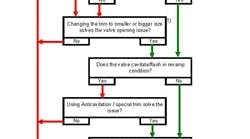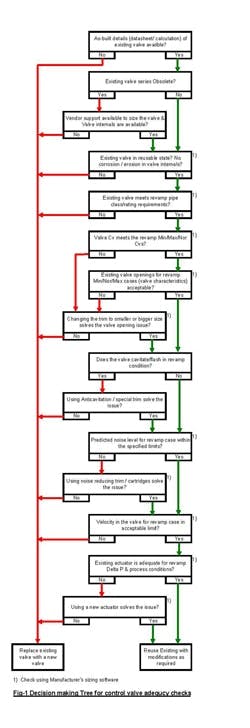The main intent of revamp and debottlenecking projects is to safely use the existing facility, equipment and installation as much as possible -- to reduce capital expenditures on material, installation, commissioning and spares. The same objective holds for in-place control and safety valves and instruments.
So, assessing whether you can retain existing devices is a critical activity. Adequacy checks include verifying plant and component safety, e.g., via Process Hazard Analysis (PHA) and Safety Integrity Level (SIL) assessment, and confirming suitability for the new process conditions.
THE STARTING POINT
Once the process diagrams and the new design conditions for the revamp are available, the immediate task is to identify the existing valves and instruments that must undergo adequacy checks. You must assess all units subject to new process conditions. These include control valves, flow instruments, safety relief valves, thermowells, pressure and temperature transmitters and gauges, analytical instruments and equipment-mounted instruments like level gauges and transmitters.
After you've pinpointed all units requiring adequacy checks, then you must gather as-built details (like datasheets, make, model, serial number, calculation sheets, catalog cut sheets, and inspection and test records) for each. The quality of documents gathered will directly bear on the quality of adequacy checks and, eventually, the success or failure of the revamp project.
Each plant handles documentation in its own way; more often than not, it's hard to get the latest information for instruments. Although use of data management packages is improving the quality of documentation and data archiving, some old plants may lack the procedures to manage the day-to-day changes and, so, documents may not be up-to-date.
Gathering details on existing instruments commonly poses a number of challenges:
• lack of instrument datasheets;
• mismatches between instrument datasheets and instruments in the field;
• missing name and tag plates (serial number information) on field devices;
• lack of instrument make or series details;
• obsolete instrument make or series;
• incomplete process data in existing datasheet or calculation sheet; and
• unavailability of functionality and operation-related issues for the existing instruments.
You thoroughly must check information gathered from the plant for correctness and update it to as-built status (if it isn't already) before using it to carry out the adequacy checks. This activity requires close interaction with plant operation and maintenance personnel so that all "known" changes are captured efficiently.
THE NEXT STEP
Once the as-built information is available, you should conduct the tough process of performing adequacy checks.
• Don't underestimate the magnitude of the work involved. Revamp projects are more complex than grassroots ones.
• Conduct as many site visits as feasible and gather as much as data as possible.
• When sizing an existing device for the new service or conditions, interact closely with the original instrument manufacturer.
• Check material compatibility of existing instruments against the new service and conditions.
• Use "risk registers" to record and escalate potential risks to project management and the end user.
• Involve all stakeholders when making the decision to reuse or replace existing instruments.
• Identify the requirement to perform PHA and SIL assessments if an existing instrument is replaced with one of a different size, type or operating principle.
Control valves. These need the most attention and time. It's prudent to use sizing software from the manufacturer of the installed valves, to ensure the adequacy check is accurate. Figure 1 shows a decision tree for checking control valves.
Most valve manufacturers keep records of the serial number and valve details in their archives for a considerable length of time. It's important to have adequacy checks carried out or reviewed by the original manufacturer and to carefully analyze its recommendations. Adequacy check reports should record the recommendation for each valve, clearly indicating if the valve is suitable for reuse as is, requires modifications or needs replacement.
The process designer and the end user also should review the adequacy reports and confirm that the process requirements are clearly understood and the decisions made are accurate.
If you're replacing valve internals (trim), the trim material must suit the new process conditions. The method (at vendor's workshop or in-situ) and the timing of the trim replacement need careful planning with the vendor, the owner and the construction team. Inform piping and process disciplines if the new valve has a bigger or a smaller body size valve than the current one.
Existing on-off valves typically are assessed for the actuator sizing for the new shut-off pressure as well as for the revamp pressure and temperature conditions. You must check the mechanical compatibility of the new actuator with the existing valve stem and space if the decision is to retain the current valve body and only replace the actuator.
Flow instruments. Inline devices like vortex, mass, magnetic and other types of flow meters also require careful adequacy checks. Generally for inline instruments, their respective vendors carry out the sizing calculations and provide the recommendation.
Typically, flow instruments are checked for the new flow range, rangability, accuracy, pressure, temperature and pressure drop. The process designer must confirm that the revamp pressure drops across the existing flow meters are acceptable.
Existing orifice plates also should undergo adequacy checks -- although replacing them doesn't cost a fortune. Calculate new pressure drops across each orifice plate with the existing orifice beta value. Unlike transmitters available today, earlier generation ones didn't have wide differential pressure (DP) ranges. Hence, a review of the existing DP transmitters for the new DP range is a must. Recalibrate existing DP transmitters for the new DP, if they can handle the range. Keep flow turndown in mind when making the reuse or replace decisions.
Process designers also may want to know the permanent pressure loss across the existing orifice plates for the revamp case.
Safety relief valves. Adequacy checks of safety valves pose similar complexity as those for control valves. Usually you must review the set pressure, spring range, material compatibility, pressure and temperature. One of the most common issues that crops up is the close gap between the operating pressure and the safety valve set pressure. In cases where the difference is less than 10%, avoid reusing conventional safety or balanced bellows valves because there's a possibility of spurious popping that can cause operational disturbances. Carefully assess such applications and consider alternatives like pilot-operated or air-assisted safety valves, depending on the type of service.
Thermowells. Usually existing thermowells are replaced. However, if it's decided to carry out an adequacy check on them, then you usually must assess their wake frequency as well as pressure and temperature data for the new process conditions. All reused thermowells should have calculations done per ASME PTC 19.3 for both process and personnel safety reasons.
Transmitters. Pressure transmitters must undergo adequacy checks to verify that pressure and temperature limits are suitable for the new condition. Diaphragm and capillary material, where applicable, must be compatible with the new process conditions and service.
Gauges. Usually the existing temperature and pressure gauges are replaced, as they aren't expensive. However if you must perform adequacy checks, assess instrument range, pressure and temperature. It's important to determine the suitability of the existing instrument's diaphragm material for the revamp conditions and service.
Instruments on equipment. Temperature, pressure and level instruments on vessels and equipment also must undergo adequacy checks. If the vessel or equipment is reused without much modification or many process changes, existing instruments likely will suffice. However, it's absolutely necessary to carry out a thorough adequacy check to ensure the existing instruments are good enough to meet the new process conditions.
Analytical instruments. Carefully review existing devices against the new process stream contents and check whether or not the existing sample gathering and conditioning units can handle them. Reverify transport time and fast loop components for adequacy.
Installation. Assess existing instruments' installations (above tap point, below tap point, etc.) for new process conditions and fluid states. Transmitters may be good for re-use but you may need to modify their installation to suit the revamp conditions.
Standards. One critical decision that you must make when reusing existing instruments is the extent to which you'll apply international standards for the revamp project -- because in-place instruments may not comply with the latest rules. Also, in some instances, the existing instruments may not even meet client or project standards. For instance, some materials that were okay in the past for sour service no longer are acceptable.
Project management must consciously decide how far to apply the latest standards. You must notify the owner of instances where existing instruments violate safety requirements of the latest standards.
AN ESSENTIAL ELEMENT
By reusing existing instruments, stakeholders can control project cost. However, reusing them for the revamp conditions can pose risks and requires careful review to mitigate potential safety or operability problems. So, adequacy checks, while time consuming, are crucial. You must allow sufficient time in the project schedule to carry out reasonable checks to ensure safe and reliable service from the existing devices under the new process conditions.
GIRISH SATHYANARAYANA is technical professional leader, instrumentation, for KBR Hydrocarbons, Singapore. Email him at [email protected].



